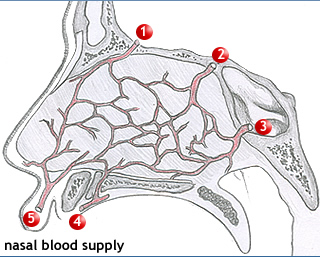|
The Nasal Cavity |
|
| Blood supply |
 |
Arteries:
Hover over the hot points in the diagram to get the names of the arteries
- There is an extensive anastomosis in the anteroinferior
part of the nasal septum. This is called Little's
area. It is a frequent site of nasal bleeding (epistaxis).
- More serious bleeding from the nose may arise while
vessels are large, just after they have entered the nasal cavity.
The Veins:
- They drain from a venous plexus, especially well
developed over the inferior concha.They accompany
the arteries for most part.
- Plexus sometimes communicates with the superior sagittal
sinus through emissary veins passing through foramen ceacum.
|
|
| Vessels of the nasal cavity |
|
The arteries are derived from the opthalmic (stemming from the internal carotid) and maxillary (stemming from the external carotid).
Opthalmic artery:
- Anterior ethmoidal artery.It supplies the lateral wall and the septum.
Maxillary artery:
- Sphenopalatine artery. It supplies the lateral wall and septum.
The veins accompany the arteries
An emissary vein to the superior sagittal sinus inside the cranium sometimes connects the venous plexus. The emissary vein traverses foramen ceacum when the latter is patent.
|
| |
| Lymphatics
|
| This is via the following nodes:
- Deep cervical
- Submandibular
- Retropharyngeal
|
| |
|
| Nasal conchae |
| |
Three conchae
- Superior (1)
- Middle (2)
- Inferior (3)
Superior and middle are parts of ethmoid. The inferior one is a separate bone.
Between the conchae are meatuses with openings of the paranasal sinuses.
- Superior meatus (s.m)
- Middle meatus (m.m)
- Inferior meatus (i.m)
|
| |
|
| Openings in the lateral
wall |

|
| Superior meatus: |
Middle meatus: |
Inferior meatus: |
- Sphenoidal sinus
- Posterior ethmoidal cells
|
- Frontal
- Anterior ethmoidal
- maxillary
- middle ethmoidal
|
Nasolacrimal duct |
|
| |
|
| Lining of the nasal
cavity |
- The walls and septum are lined with mucosa
except the vestibule, which is lined with skin.
- The mucosa is closely
adherent to the periosteum or perichondrium. The fused layers form either
the mucoperiostium or mucoperichondrium, which may easily be stripped
off bone or cartilage .
- The mucosa contains numerous glands and venous
plexuses.
- The veins tend to become engorged when irritated and then
tend to block the nasal passages.
|
| |
|
|
| Nerves
of the nasal cavity |
| |
Special sensation: The olfactory region
is supplied by olfactory nerves. They run a short course, passing through
the cribriform plate to reach the olfactory bulb.
|
| |
|



